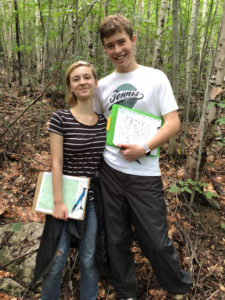Summer Student Spotlight: Charlie Mann ’19
Rising senior Charlie Mann was thrilled when Science Department Chair Sue Foster told him about an opportunity to work with Professor Ruth Yanai at ESF this summer. He’s been working in her lab a couple days a week and is currently at Bartlett Experimental Forest in New Hampshire with some of her team members doing field work as part of the Multiple Element Limitation in Northern Hardwood Ecosystems (MELNHE) project. Their team is studying N and P acquisition and limitation through a series of nutrient manipulations in northern hardwood forests.
Here’s Charlie’s first-hand account of his experience, as published on the MELNHE Blog.

Groundtruthing the MELNHE Inventory Plots
Hi. My name is Charlie Mann. I’m currently a rising senior at Manlius Pebble Hill School in Dewitt, New York. I began working in the ESF lab at the beginning of the summer and it has very quickly become a priority in my weekly schedule. I’ve sorted leaves, seeds, sifted a couple stands of soil, reorganized the freezers, and combed through years of data. This week, however, I grabbed my rain pants and hiking boots and left the lab to work with the MELNHE field crew in New Hampshire. Yesterday, I helped ground truth one of the plots.
We started the day with a brief hike up to C5 to check all the stem maps. We could tell something was off since there were not supposed to be any trees in the C5-4-A1 subplot, so we skipped that subplot for now. At the next subplot, none of the trees on the plot existed on the map of the subplot, but they did exist in a different subplot. How’d that happen? We still don’t quite know for sure, but each plot was not where it was supposed to be. We were able to properly reorganize and understand the errors since each subplot had been shifted on the map, but that was not the case for the next plot. We hoped that this plot didn’t have the same tragic mistake as the previous plot, and it didn’t! Entire plots were not in the wrong location. No. Now each individual tree was shuffled. Needless to say, we skipped this entire plot. The last two plots, C5-2 and C5-1, went much faster and we were able to check the species, location, and ID code of each tree with a greater efficiency. It could be because these last two plots didn’t have major errors like the others, but we had also began enjoying the problem solving. Working through the problems and color coding the stem maps was really enjoyable. We decided to come back tomorrow and finish the plots we skipped.
Although hiking through the weeds and the brush is not exciting to me, we are going back today to finish the C5-3 plot. And that excites me.
The Next Day
We finished remapping the C5-3 plot and it turned out great. The location of each tree in each subplot of C5-3 has been successfully completed in which seemed to take less time than the last two plots we did yesterday. Although it was labor intensive, the weather held up today and we have a piece of work ready to be mapped in ArcGIS!
This hands-on approach to learning coupled with amazing research opportunities is just a part of what makes our Upper School experience unique and extraordinary. That’s the MPH Effect!
